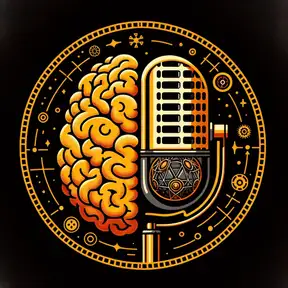The Psychological Power of Art and Creativity: Why We Create and How It Shapes Us
The Psychological Power of Art and Creativity: Exploring Why We Create
In this episode of PsyberSpace, hosted by Leslie Poston, we explore the profound psychological impact of art and creativity. Using examples like Dylan Thomas's poem 'Do Not Go Gentle into That Good Night' and Maya Angelou's 'Still I Rise,' the episode delves into why art moves us and how creativity nurtures our mental well-being. The discussion touches on how art activates brain reward centers, fosters empathy, and acts as a form of resistance and resilience, especially for marginalized communities. The episode also emphasizes the therapeutic benefits of engaging in creative activities and encourages listeners to incorporate more art and creativity into their daily lives.
00:00 Introduction to PsyberSpace
00:26 The Psychological Power of Art and Creativity
00:54 Analyzing Dylan Thomas's Iconic Poem
01:39 The Neuroscience Behind Art's Impact
02:47 Art as a Shared Experience
04:38 The Role of Metaphor in Art
05:32 Art as a Catalyst for Change
07:14 The Therapeutic Power of Creativity
09:31 Creativity in the Digital Age
11:51 Art as Cultural Preservation and Resistance
16:07 Practical Tips for Unleashing Creativity
17:22 Conclusion and Final Thoughts
References and Links
Additional Resources
In this episode of PsyberSpace, hosted by Leslie Poston, we explore the profound psychological impact of art and creativity. Using examples like Dylan Thomas's poem 'Do Not Go Gentle into That Good Night' and Maya Angelou's 'Still I Rise,' the episode delves into why art moves us and how creativity nurtures our mental well-being. The discussion touches on how art activates brain reward centers, fosters empathy, and acts as a form of resistance and resilience, especially for marginalized communities. The episode also emphasizes the therapeutic benefits of engaging in creative activities and encourages listeners to incorporate more art and creativity into their daily lives.
00:00 Introduction to PsyberSpace
00:26 The Psychological Power of Art and Creativity
00:54 Analyzing Dylan Thomas's Iconic Poem
01:39 The Neuroscience Behind Art's Impact
02:47 Art as a Shared Experience
04:38 The Role of Metaphor in Art
05:32 Art as a Catalyst for Change
07:14 The Therapeutic Power of Creativity
09:31 Creativity in the Digital Age
11:51 Art as Cultural Preservation and Resistance
16:07 Practical Tips for Unleashing Creativity
17:22 Conclusion and Final Thoughts
References and Links
Additional Resources
Poetry Foundation. (n.d.). Poems and poets. https://www.poetryfoundation.org
Poets.org. (n.d.). Poems and poets. https://poets.org
Michael Sheen "Do not go gentle" https://www.youtube.com/watch?v=w-sM-t1KI_Y
Maya Angelou "Still I Rise" https://www.youtube.com/watch?v=qviM_GnJbOM
Michael Sheen "Do not go gentle" https://www.youtube.com/watch?v=w-sM-t1KI_Y
Maya Angelou "Still I Rise" https://www.youtube.com/watch?v=qviM_GnJbOM
Psychology of Art and Creativity
Csikszentmihalyi, M. (1990). Flow: The psychology of optimal experience. Harper & Row.
Dissanayake, E. (1995). Homo aestheticus: Where art comes from and why. University of Washington Press.
Kidd, D. C., & Castano, E. (2013). Reading literary fiction improves theory of mind. Science, 342(6156), 377–380.
Lakoff, G., & Johnson, M. (1980). Metaphors we live by. University of Chicago Press.
McCrae, R. R., Greenberg, D. M., & Tamir, M. (2009). Aesthetic chills: A review of the empirical literature. Psychology of Aesthetics, Creativity, and the Arts, 3(4), 219–228.
Thibodeau, P. H., & Boroditsky, L. (2011). Metaphors we think with: The role of metaphor in reasoning. PLOS ONE, 6(2), e16782.
Vessel, E. A., Starr, G. G., & Rubin, N. (2012). The brain on art: Intense aesthetic experience activates the default mode network. Frontiers in Human Neuroscience, 6, 66.
Winner, E., Goldstein, T. R., & Vincent-Lancrin, S. (2013). Art for art’s sake? The impact of arts education. OECD Publishing.
Zeki, S., Romaya, J. P., Benincasa, D. M. T., & Atiyah, M. F. (2014). The experience of mathematical beauty and its neural correlates. Frontiers in Human Neuroscience, 8, 68.
Art Therapy and Mental Health
Malchiodi, C. A. (2012). Handbook of art therapy (2nd ed.). Guilford Press.
Stuckey, H. L., & Nobel, J. (2010). The connection between art, healing, and public health: A review of current literature. American Journal of Public Health, 100(2), 254–263.
Poetry and Art References
Angelou, M. (1978). And still I rise. Random House.
Clifton, L. (1993). The book of light. Copper Canyon Press.
Lorde, A. (1978). The black unicorn. W. W. Norton & Company.
Thomas, D. (1952). Do not go gentle into that good night. In Collected poems, 1934–1952. Dent.
Cultural and Historical Context
Baraka, A. (1964). Dutchman and The slave. Harper Perennial.
Simone, N. (1969). To be young, gifted and black [Recorded by Nina Simone]. On Black gold [Album]. RCA Victor.
Evolutionary Psychology
Dissanayake, E. (1992). Homo aestheticus: Where art comes from and why. Free Press.
Creators and Guests


